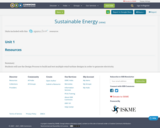
Students will use the Design Process to build and test multiple wind turbine designs in order to generate electricity.

Students will use the Design Process to build and test multiple wind turbine designs in order to generate electricity.
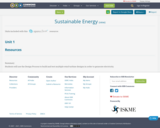
Students will use the Design Process to build and test multiple wind turbine designs in order to generate electricity.
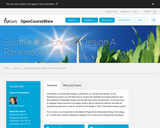
A transition to sustainable energy is needed for our climate and welfare. In this engineering course, you will learn how to assess the potential for energy reduction and the potential of renewable energy sources like wind, solar and biomass. You’ll learn how to integrate these sources in an energy system, like an electricity network and take an engineering approach to look for solutions and design a 100% sustainable energy system.
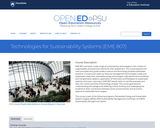
EME 807 overviews a wide range of contemporary technologies in the context of sustainability and examines metrics for their assessment. The course explores the main principles that guide modern science and technology towards sustainable solutions. It covers such topics as resource management technologies, waste and wastewater treatment, renewable energy technologies, high performance buildings and transportation systems, application of informatics and feedback to sustainable systems, and more. Learning in EME 807 heavily relies on real-life examples and taps into current practices of technology analysis. This course goes beyond understanding the background, fostering critical thinking and challenging the students to draw connections between social, environmental, and economic aspects of sustainable technologies.

Students learn about wind as a source of renewable energy and explore the advantages and disadvantages wind turbines and wind farms. They also learn about the effectiveness of wind turbines in varying weather conditions and how engineers work to create wind power that is cheaper, more reliable and safer for wildlife.
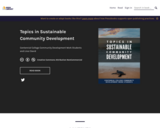
Long Description:
CREDITS:
Cover Photo by Darwis Alwan from Pexels
Word Count: 5321
(Note: This resource's metadata has been created automatically by reformatting and/or combining the information that the author initially provided as part of a bulk import process.)
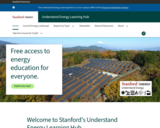
Stanford University’s Understand Energy Learning Hub provides free access to Stanford course content on energy resources from fossil fuels like oil and coal to renewable resources like the wind, the sun, and efficiency; energy currencies like electricity and hydrogen; and energy services such as transportation and buildings. Explore the Hub and build your energy literacy to address climate change and sustainability issues, engage on equity and human development challenges, participate in energy industry markets and technology innovations, and make informed energy decisions.

This resource is a video abstract of a research paper created by Research Square on behalf of its authors. It provides a synopsis that's easy to understand, and can be used to introduce the topics it covers to students, researchers, and the general public. The video's transcript is also provided in full, with a portion provided below for preview:
"Dr. Dey and his team from India have found a rather extraordinary use for an otherwise ordinary material. They’ve developed a supercapacitor capable of storing nearly one-third as much energy as an alkaline battery using peanut shells. A much cheaper and safer alternative to the toxic materials found in most energy storage devices, peanut shells could be a welcome ingredient that powers our increasingly electronic world. Peanut shells aren’t inherently good at storing charge. But locked inside their complex carbon-based structure is the potential to extract a valuable “wonder material” that is: graphene. To do that, the research team used common methods for obtaining graphene from biomass. They crushed and carbonized the shells in the lab—but then added two important steps. First, the team blasted their blackened peanut-shell powder with ultrasound waves. Much like the peanut, graphene is best when peeled..."
The rest of the transcript, along with a link to the research itself, is available on the resource itself.
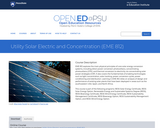
EME 812 explores the main physical principles of core solar energy conversion systems, including direct power conversion photovoltaics, concentrating photovoltaics (CPV), and thermal conversion to electricity via concentrating solar power strategies (CSP). It also covers the fundamentals of enabling technologies such as light concentration, solar tracking, power conversion cycles, power conditioning and distribution. Learning in EME 812 relies on analysis of design and performance of existing solar plants that have been deployed in areas such as the southwestern USA, Spain, and North Africa.

More than 4000 hydroelectric dams have been built in the United States since the late 19th century, representing six percent of all-time additions to electric generation capacity from all sources.

In 2022, the United States saw a significant rise in solar power generation, with 5730 utility-scale solar PV plants and 13 solar thermal plants producing 146 terawatt-hours (TWh) of electricity, equal to 3.4% of total utility-scale generation. This growth traces back to the 2000s, marked by falling solar system costs, enhanced efficiency, and government incentives like the American Recovery and Reinvestment Act of 2009.
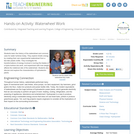
Students learn the history of the waterwheel and common uses for water turbines today. They explore kinetic energy by creating their own experimental waterwheel from a two-liter plastic bottle. They investigate the transformations of energy involved in turning the blades of a hydro-turbine into work, and experiment with how weight affects the rotational rate of the waterwheel. Students also discuss and explore the characteristics of hydroelectric plants.

The world energy system is experiencing seismic shifts, with a rapid expansion of low-carbon fuels and energy efficiency. However, fossil fuels still dominate investments despite the need to reduce greenhouse gas emissions. Different countries prioritize energy RD&D in diverse ways, and state-owned enterprises play a significant role.

Biopower is electricity generated from renewable organic materials, such as plants and animals. Different countries rely on various biomass sources, including sugarcane, trees, and municipal waste, to produce biopower. However, the impact of biopower on climate change is complex. Despite being initially perceived as carbon neutral, the use of fossil fuels in bioenergy systems and the land requirements for biomass production can have significant environmental consequences.
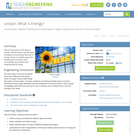
With an introduction to the ideas of energy, students discuss specific types of energy and the practical sources of energy. Hands-on activities help them identify types of energy in their surroundings and enhance their understanding of energy.

Women represent 40% of the global solar photovoltaic (PV) workforce, double the share in the wind industry and oil and gas sector. However, they are mainly in administrative and non-STEM technical positions, with underrepresentation in STEM and senior management roles. Gender bias and barriers to recruitment, advancement, and work-life balance exist in the industry, with women reporting higher perception of pay gaps and barriers.

The global wind energy industry has seen substantial growth, but women make up only 21% of its workforce, lagging behind other renewable energy sectors. Barriers to gender equity include cultural norms, limited awareness of opportunities, and lack of support policies. Companies can promote change by prioritizing fairness, transparency, and work-life balance.

Biopower is the production of electricity from biomass-derived fuels, with significant growth in Brazil due to sugarcane-based ethanol byproducts, while in certain regions like the United States, Germany, and the United Kingdom, waste-to-energy facilities are used due to land constraints and landfill opposition.

Hydropower's history traces back to 1882 when the first facility began supplying electricity in Wisconsin. Its adoption surged across North America, Europe, and beyond, with China notably driving expansion in recent decades. Hydropower now contributes 17% of global electricity, surpassing nuclear, wind, solar, bioenergy, and geothermal combined.

Geothermal power has a long history, with Native Americans and ancient civilizations like the Greeks and Romans utilizing its benefits. Today, countries such as the United States, Indonesia, the Philippines, Turkey, and New Zealand are leading the way in building new geothermal power projects to harness clean and sustainable energy from the Earth's heat.